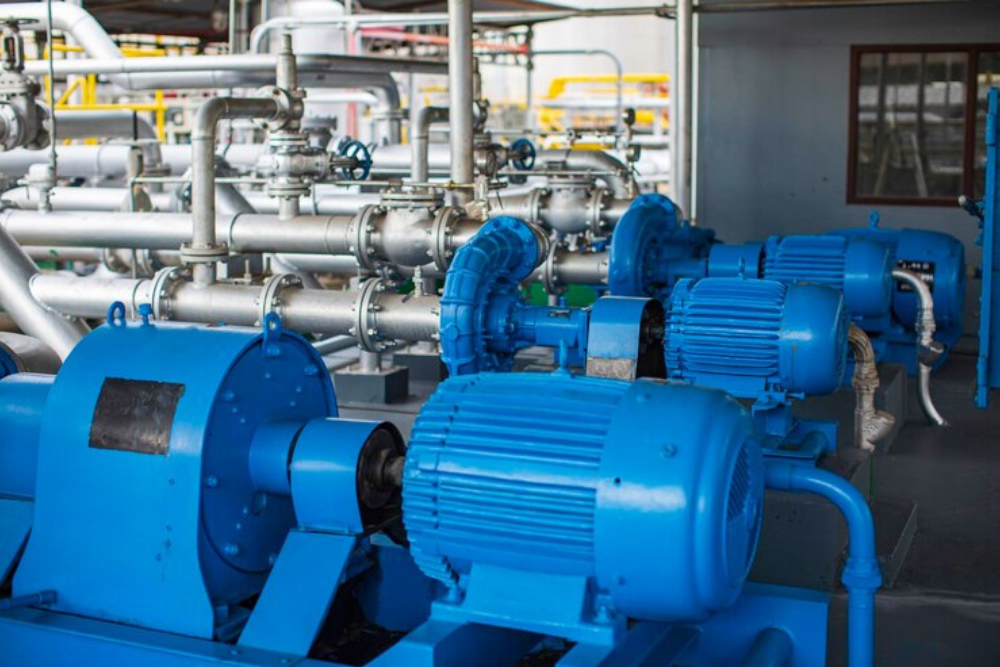Fluid dynamics is a complex and fascinating field that examines the behaviour of fluids (both liquids and gases) in motion. Among the many concepts within this field, Total Dynamic Head (TDH) is a critical factor in understanding and designing systems that involve fluid flow, particularly in pumps. TDH encompasses various energy components within a fluid system, ensuring the efficient and effective transport of fluids. Let’s explores the science behind TDH, its components, its calculation, and its significance in fluid dynamics, with a focus on practical applications and industry relevance.
What is Total Dynamic Head?
The Total Dynamic Head (TDH) serves as a gauge of the energy needed to propel fluid within a system. It encompasses elements that need to be surpassed for fluid transfer, from one location to another. These elements include:
Static Head: The vertical distance known as Static Head plays a role, in situations where fluids need to be moved from a source to their destination. It becomes especially important in scenarios, like water supply systems that move water uphill from a reservoir to areas. Static head considers the energy required to lift the fluid vertically.
Friction Head: Friction Head refers to the energy lost when fluid moves, through a system. This loss is caused by friction between the fluid and the surfaces inside pipes and other parts. Several factors affect friction head, like pipe length and diameter surface roughness, flow rate and fluid viscosity. It’s crucial to reduce friction head for transport because too much energy loss can increase operating expenses and lower system efficiency.
Velocity Head: Velocity Head represents the kinetic energy of the fluid due to its movement. Although this component is often small compared to static and friction heads, it becomes significant in systems with high flow velocities. In such cases, the velocity head must be taken into account to ensure accurate TDH calculations and efficient system design.
Dynamic Head of Pump
The dynamic head of pump refers specifically to the energy that the pump must impart to the fluid to overcome both the friction and velocity components within the system. It is a subset of the Total Dynamic Head and focuses on the energy required to maintain fluid motion through the system once elevation (static head) is accounted for.
Significance of Dynamic Head
Dynamic head is significant because it directly impacts the efficiency and performance of the pump. While static head addresses the gravitational potential energy needed to move fluid to a certain height, dynamic head encompasses the continuous energy input required to maintain fluid flow through pipes, valves, fittings, and other system components.
In essence, the dynamic head represents the “work” the pump must do to counteract the resistance offered by the system due to friction and maintain the desired flow rate. Understanding the dynamic head is crucial for several reasons:
- Energy Efficiency: By accurately determining the dynamic head, engineers can select pumps that operate efficiently, minimizing energy consumption and operational costs.
- System Performance: Ensuring that the pump can handle the dynamic head ensures reliable system performance, preventing issues such as flow reduction or pump failure.
- Maintenance and Longevity: Properly sized pumps that effectively manage dynamic head experience less wear and tear, leading to reduced maintenance needs and longer equipment lifespan.
Factors Affecting Dynamic Head
Several factors influence the dynamic head of a pump, including:
- Pipe Length and Diameter: Longer pipes and smaller diameters increase friction losses, thus raising the dynamic head.
- Pipe Material and Roughness: Smooth pipes cause less friction, while rough or corroded pipes increase resistance to flow.
- Flow Rate: Higher flow rates result in greater friction losses, increasing the dynamic head required to maintain flow.
- System Components: Valves, bends, and fittings introduce additional resistance, contributing to the overall dynamic head.
- Fluid Properties: The viscosity and density of the fluid affect how easily it flows through the system, impacting the dynamic head.
Calculating Dynamic Head
To calculate the dynamic head, engineers need to evaluate the friction and velocity components within the system. This involves analyzing the entire piping network, including lengths, diameters, and the number and type of fittings. By understanding these parameters, engineers can estimate the energy losses due to friction and the energy required to maintain fluid velocity.
Accurate dynamic head calculations enable the selection of pumps that can efficiently overcome these losses, ensuring optimal system performance. Additionally, understanding the dynamic head helps in identifying areas where system improvements can be made, such as upgrading pipes or reducing flow resistance through better design.
Practical Applications of Total Dynamic Head
TDH plays a vital role in various industries and applications where fluid transport is critical. Understanding and managing TDH ensures that systems operate efficiently, reliably, and cost-effectively. Here are some key areas where TDH is particularly important:
Water Supply and Distribution
In municipal water supply systems, TDH is crucial for determining the capacity and power requirements of pumps. These pumps must deliver water from reservoirs to households and businesses, often overcoming significant elevation differences and friction losses in the distribution network. Accurate TDH calculations ensure that the system can meet demand while minimizing energy use.
Irrigation Systems
Agricultural irrigation systems rely on precise TDH calculations to ensure efficient water delivery to fields. By optimizing pump selection and system design based on TDH, farmers can maximize water use efficiency, reduce energy consumption, and improve crop yields. This is especially important in regions where water resources are limited.
HVAC Systems
Heating, ventilation, and air conditioning (HVAC) systems use TDH to design and size pumps for circulating water or refrigerant. Properly calculated TDH ensures that these systems maintain desired temperature and humidity levels while operating efficiently. This results in comfortable indoor environments and reduced energy costs.
Industrial Processes
Many industrial processes, such as chemical manufacturing, food and beverage production, and wastewater treatment, involve transporting fluids through complex piping networks. TDH is critical in designing pumps and piping systems that meet specific process requirements. Accurate TDH calculations help in optimizing system performance, reducing operational costs, and minimizing downtime.
Mining and Slurry Handling
In mining operations, the transport of slurry—a mixture of water and solid particles—requires careful consideration of TDH. Slurry transport systems must account for the additional friction and potential wear and tear on equipment. Proper TDH calculations ensure that pumps can handle abrasive materials efficiently, reducing maintenance costs and improving reliability.
Oil and Gas Industry
The oil and gas industry involves the extraction, processing, and transport of fluids through extensive pipeline networks. Accurate TDH calculations ensure that pumps and compressors are appropriately sized to maintain flow rates and pressure levels. This minimizes the risk of pipeline failures and ensures safe and efficient operation.
Importance of Total Dynamic Head in Pump Selection
Selecting the right pump for a given application requires a thorough understanding of the system’s TDH. An undersized pump may fail to deliver the required flow rate, leading to inadequate system performance. Conversely, an oversized pump can result in excessive energy consumption, increased operational costs, and potential system damage. Here are the steps involved in pump selection:
System Analysis: Conduct a detailed analysis of the system, including the layout of the piping network, elevation changes, and the types of fluids being transported. This analysis forms the basis for accurate TDH calculations.
Calculate TDH: Determine the static head, friction head, and velocity head to calculate the total dynamic head for the system. This calculation provides the necessary information to select an appropriate pump.
Determine Flow Rate: Establish the required flow rate based on the application needs. For example, an irrigation system may require a specific volume of water per hour, while an HVAC system may need a certain rate of coolant circulation.
Select Pump Curve: Use the TDH and flow rate to find a pump curve that matches these parameters. Pump curves illustrate the relationship between flow rate and head for different pump models and sizes, helping to identify the best fit for the system.
Evaluate Efficiency: Consider the pump’s efficiency at the operating point—the combination of TDH and flow rate. Efficient pump operation reduces energy consumption and operational costs.
Consider Reliability and Maintenance: Evaluate the pump’s reliability, maintenance requirements, and lifespan. A well-chosen pump should meet the operational demands of the application while minimizing downtime and maintenance costs.
Advanced Techniques in TDH Calculation and Pump Optimization
Modern advancements in technology and computational methods have enhanced the accuracy and efficiency of TDH calculations and pump optimization. These advancements help in designing more efficient and reliable fluid transport systems. Here are some of the key techniques and tools:
Computational Fluid Dynamics (CFD): Computational Fluid Dynamics (CFD) is a powerful tool for simulating fluid flow and analyzing the behavior of fluids in complex systems. By creating detailed models of the piping network and the pump, engineers can use CFD to predict pressure losses, velocity distributions, and potential areas of turbulence. This information helps refine TDH calculations and optimize system design for improved performance.
Variable Frequency Drives (VFDs): Variable Frequency Drives (VFDs) allow for precise control of pump speed, enabling adjustments based on real-time system demands. VFDs help pumps operate efficiently across a range of flow rates and heads, reducing energy consumption and extending equipment lifespan. They are particularly useful in applications where flow demand varies significantly over time.
Smart Pumping Systems: The integration of sensors, data analytics, and automation has led to the development of smart pumping systems. These systems continuously monitor parameters such as flow rate, pressure, and energy consumption. Using this data, smart systems adjust pump operation for optimal performance. Leveraging the Internet of Things (IoT) and machine learning algorithms, smart pumping systems can predict maintenance needs, identify inefficiencies, and provide recommendations for system improvements.
Advanced Materials and Coatings: Advancements in materials and coatings have improved the durability and efficiency of pumps and piping systems. Materials resistant to corrosion, abrasion, and chemical attack help reduce friction losses and maintain system integrity over longer periods. These advancements contribute to more accurate TDH calculations and lower operational costs.


Videos